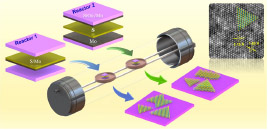Department of Physics and Astronomy: Publications and Other Research
Date of this Version
2006
Document Type
Article
Citation
PHYSICAL REVIEW B 73, 155327
Abstract
The materials and magnetic properties of Cr-doped anatase TiO2 thin films deposited on LaAlO3(001) and SrTiO3(001) substrates by oxygen-plasma-assisted molecular beam epitaxy have been studied in detail to elucidate the origin of ferromagnetic ordering. Cr substitution for Ti in the anatase lattice, with no evidence of Cr interstitials, segregation, or secondary phases, was independently confirmed by transmission electron microscopy with energy dispersive x-ray spectroscopy, extended x-ray absorption fine structure, and Rutherford backscattering spectrometry in the channeling geometry. Epitaxial films deposited at ~0.1 Å/ s were found to have a highly defected crystalline structure, as quantified by high-resolution x-ray diffraction (XRD). These films were also ferromagnetic at room temperature with a moment of ~0.5μB/ Cr, Curie temperatures in the range of 400–700 °C, and exhibited shape and in-plane magnetocrystalline anisotropy. However, no free carrier spin polarization was observed by Hall effect measurements, raising questions about the mechanism of magnetism. Films deposited slowly (~0.015 Å/s) possessed a nearly perfect crystalline structure as characterized by XRD. Contrary to expectations, these films exhibited negligible ferromagnetism at all Cr concentrations. Annealing in vacuum to generate additional oxygen defects and free carrier electrons did not significantly increase the ferromagnetic ordering in either fast- or slow-grown films. These results contradict both oxygen-vacancy-derived free-carrier-mediated exchange and F-center-mediated bound magnetic polaron exchange mechanisms, and instead indicate the primary role of extended structural defects in mediating the ferromagnetic ordering in doped anatase films.


Comments
Used by permission.